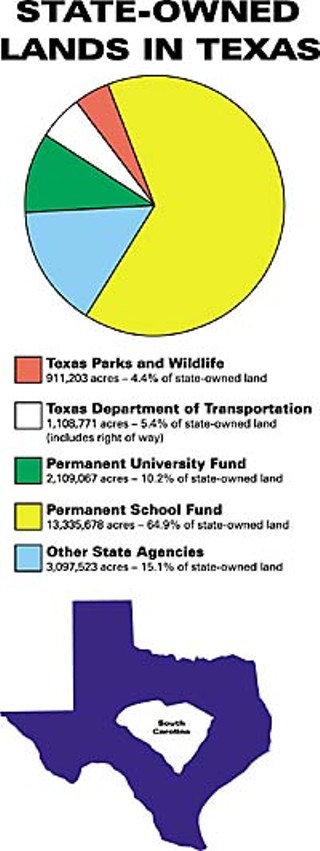Going Public
Sunset Commission Recommends Opening Texas' Lands to Public Use
By Robert Bryce, Fri., May 19, 2000

Every once in a while, a government agency makes a recommendation that makes so much sense that people slap their foreheads and say, "Duh. Of course we should do that." That's been the reaction in many quarters to a new report by the Sunset Review Commission on the Texas Parks and Wildlife Department. It's no secret that Texas has a paucity of parks, or that Texas ranks 48th among the 50 states when it comes to parkland spending. But as the Sunset Commission report points out, that doesn't mean Texas lacks state-owned land. In fact, the opposite is true: Texas taxpayers own more than 20 million acres of land, or about 13% of all the land in the state. The problem is that only about one million acres of it fall under the aegis of the Texas Parks and Wildlife Department (TPWD). The rest is owned by state entities that must be persuaded to open their property to public use.
The Sunset Commission wants to change that. The report, which covers numerous other topics important to TPWD, says that although "most state agencies do not have a primary interest in the conservation and recreational potential of their lands, the lands do have value to the state of Texas." The commission suggests that all state lands be assessed for their potential hunting and recreational value.
The report (available at www.sunset.state.tx.us) is being released at a time when demand for recreational opportunities in Texas is growing. And it's being welcomed by parks experts, environmentalists, and hunters, all of whom are eager to see more open space in Texas.

The timing of the report could scarcely be better. Several groups have formed in recent months to promote parks and open space. In the Austin area, the Austin-San Antonio Corridor Council has launched an effort to acquire parkland throughout the corridor. The Hill Country Conservancy, a new group headed by Austin environmentalist George Cofer that has backing from the Real Estate Council of Austin and the Greater Austin Chamber of Commerce, has begun looking at land acquisition in the Barton Springs watershed. The Texas Nature Conservancy has launched an aggressive effort to preserve large tracts of land in West Texas and other areas like the Edwards Plateau.
On the state level, Gov. George W. Bush created a conservation task force three months ago that will be headed by Texas Parks and Wildlife Commissioner Carol Dinkins. The group has been asked to "recommend strategies to conserve Texas natural resources and promote outdoor recreation in the 21st century." That charge, coupled with the work of an interim committee being chaired in the Texas House by Rep. Robby Cook, D-Eagle Lake, will likely result in legislation next year that could finally allow the public to utilize thousands of acres of state-owned land for everything from hunting to mountain biking.
Although the report outlines a plan for state-owned lands and TPWD, many stumbling blocks must be overcome. First, the lands have to be inventoried, surveyed, and mapped for their ecological and recreational values -- a big project when an area nearly the size of South Carolina is divided among thousands of parcels scattered across the state. Second, a plan will have to be developed for managing access and providing a police presence on the land. Third, the Texas Legislature will have to appropriate money to start and sustain the project. Finally, Land Commissioner David Dewhurst will have to embrace the proposal.
And, at present, Dewhurst appears opposed to any wholesale changes in state policy. In a May 8 letter to Joey Longley of the Sunset Commission, the land commissioner said he "welcomes any opportunity to generate additional revenues" from state land. But he pointed out that 90% of the Permanent School Fund lands are in the Trans-Pecos region in West Texas. Dewhurst also said the GLO would happily sell to TPWD any properties that it is offering for sale, but that it cannot agree to sell any state land for a "value significantly lower than what the market would have paid for the highest and best use of the property."

Photo Courtesy of Texas Audubon Society.
Despite Dewhurst's reservations, though, many observers believe the goal of the new report is attainable. Lowell Lebermann, a former regent at UT, says he "can't think of any downside" to the new proposal. His only concern for the lands owned by the university was that they continue to be available for other revenue-producing purposes, including agriculture and mineral extraction. UT's support will be critical for any new program, as the Permanent School Fund and the Permanent University Fund together own more than 15.4 million acres of land in the state.
Andrew Sansom, the executive director of TPWD and a longtime advocate of parkland acquisition, heartily endorses the new proposal. "Texas has such a tiny amount of public land that the idea that we should examine each piece of state property for the broadest array of public uses is the right idea," he says.
Valerie Bristol, the executive director of the Texas office of the Trust for Public Land, is also pleased. Bristol, a former Travis County commissioner, says the Sunset Commission's report meshes well with her organization's efforts to promote the Texas Our Texas Heritage Program. Launched last year, the program hopes to convince the Texas Legislature to spend $1 billion over the next 10 years to acquire parks and open space. Leaders of the group point out that other big states have already launched similar efforts. Florida is in the midst of a $3 billion land-acquisition program designed to preserve open space and wild lands. Over the next 10 years, New Jersey will spend $1 billion to buy farmland, parks, and watershed lands. And New York is spending $1.75 billion on a variety of environmental programs, including watershed acquisition.
Bristol says the Sunset Commission report, coupled with the governor's task force and work already being done by TPWD, bodes well for open space and parkland acquisition for the next few years. "We've always had so much land in Texas that people took it for granted," she says. But as the state continues to urbanize, "open space and recreation needs have to be addressed before it becomes impossible to do so."
Sharing the Wealth
Shortly after the new report was issued, TPWD staffers began looking at the list of state-owned land included in the Sunset Commission's report. It quickly became apparent that the available land is actually far less than the 20 million acres mentioned by the commission; in fact, nearly five million acres of that total is underwater in the Gulf of Mexico. Subtract another six million acres for lands on which the state only owns subsurface mineral rights, and the real amount of usable state land drops to about eight million acres. Of that total, more than a quarter lies in the arid reaches of West Texas, far from the urban centers where the demand for outdoor recreation space is growing fastest.

Photo Courtesy of Odessa Parks and Recreation Department.
Despite all that, there are still hundreds of tracts of state-owned land that can benefit the public. Sansom points out that there are numerous examples of shared land use that are benefiting Texas park users right now. For instance, TPWD leases 30,000 acres from the General Land Office in Brewster County that is part of the Black Gap Wildlife Management Area. It also leases 21,000 acres of GLO-controlled coastal wetlands on Matagorda Island and several other tracts along the Gulf Coast that are used as wildlife preserves. Expanding the amount of state land that is open to the public would not pose an undue burden on TPWD, Sansom says, because his department already employs nearly 500 game wardens who could provide some level of police protection. "We have game wardens in all those counties anyway," Sansom says.
In Odessa, residents enjoy greater access to numerous sports thanks to a cooperative agreement between the city and the University of Texas System. Odessa leases 100 acres of land from UT adjacent to UT-Permian Basin. Odessa's Parks Department has spent millions of dollars improving the land and has built softball, baseball, and soccer fields as well as basketball courts, picnic pavilions, parking lots, and restrooms. The park is open to local residents and UTPB students, who use the sports complex for their intramural games. "It's a great shared use," says Steve Patton, director of Odessa's Parks and Recreation Department. "For the city, land costs are always a big-ticket item. But with this arrangement, we have the use of the property without the cost of land purchase. And our programs complement the university's programs," he says.
The Texas Audubon Society leases about 5,000 acres of coastal land from the state, including several important rookery islands. One of these is Sundown Island, a 45-acre tract that provides critical nesting habitat for the brown pelican, an endangered water bird that has made a strong comeback in recent years. "In 1988, there were 12 pair of brown pelicans. Now there are over 1,200 pair. Sundown Island has been integral in bringing back the brown pelican from a severely endangered bird to one that's fairly common along the Texas coast," says John Szypula, the director of education for the Texas Audubon Society.
Not only do the lands provide habitat for birds, they also provide ongoing benefits to birdwatchers and other people who enjoy the outdoors. Leasing the state land is "a good deal for Audubon because we get to accomplish our mission of protecting birds and other wildlife," says Szypula. "And it's a good deal for Texans because we are doing the conservation that needs to be done, while the state earns money on the land we are leasing."
Support for expanded recreational opportunities in Texas appears to be growing. Last year, a poll paid for by the Trust for Public Lands found that nearly 70% of the registered voters surveyed said that they would pay a dollar or more per month in taxes to protect and expand open space and natural areas.
The May 6 election in San Antonio offered more proof of the public's support for parks and open space. In the same election in which all the other tax proposals failed -- including a $1.5 billion referendum on light rail -- San Antonio voters approved a $65 million proposal for land acquisition to protect the Edwards Aquifer Recharge Zone, and for park construction along Salado and Leon creeks. San Antonio residents were obviously concerned about the Edwards Aquifer, which provides all of their drinking water. But they were also saying, "if you can leverage it by having open space, all the better," says Ted Siff, an Austin-based consultant on land-conservation issues.
While many voters support the push for parks, the real fight for new parks will occur in the Texas Legislature, which has historically been reluctant to pay for parks, a fact borne out by U.S. Census Bureau statistics. While other states spend an average of $17.31 per person each year on parks, Texas spends just $3.51, making it the third-worst state in the U.S. in that category.
Despite the Legislature's dismal record, things appear to be improving. During the last session, TPWD got an additional $37 million for the biennium, the biggest revenue increase in the agency's history. Add to that Governor Bush's newfound interest in parks, the push in the private sector for parkland, and the Sunset Commission's report, and there may actually be enough support in the coming session to get meaningful legislation passed to improve and expand the state's park system. ![]()
Got something to say on the subject? Send a letter to the editor.








